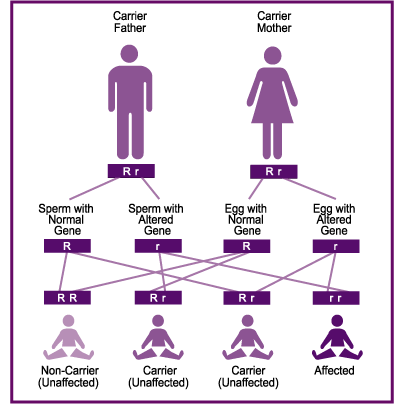It's about a missing enzyme.
Tay-Sachs disease is caused by the absence or significantly reduced level of a vital enzyme called beta-hexosaminidase. It is the Hexosaminidase A (HEXA) gene in the DNA that provides instructions for making this enzyme. Without the correct amount of the HexA enzyme, a fatty substance or lipid called GM2 ganglioside accumulates abnormally in cells, especially in the nerve cells of the brain. This ongoing accumulation, also called "substrate", causes progressive damage to the cells.
Infantile Tay-Sachs is typically the absence of the HexA enzyme. This differs from the Juvenile and Late Onset forms of Tay-Sachs when the mutations allow the HexA enzyme to function a little bit. Just a small increase in HexA activity is enough to delay the onset and slow the progression of symptoms.
Inheritance
Tay-Sachs is an autosomal recessive genetic disorder. Autosomal means it affects males and females equally and recessive means both parents must be a carrier for the children to be at risk. If both parents are carriers, there is a 25% chance with each pregnancy that the child will be affected. Carriers of recessive diseases do not experience any adverse health effects. ANYONE can be a carrier of Tay-Sachs but French Canadians, Louisiana Cajuns and Ashkenazi Jews are at high risk with an carrier rate of 1/27. Some data suggests people of British Isle and Irish descent are at increased risk between 1/50 to 1/150. The Tay-Sachs gene occurs in the general population at a rate of 1/250.
Tay-Sachs "breeds true" in a family. If one child is diagnosed with Infantile Tay-Sachs, the other children are only at risk for the infantile form. One set of parents could not have children with both the infantile and juvenile forms of the disease.
Gene Location
The gene that causes Tay-Sachs is located on chromosome 15, specifically 15q23-q24.
 Read more About Inheritance
Read more About Inheritance


